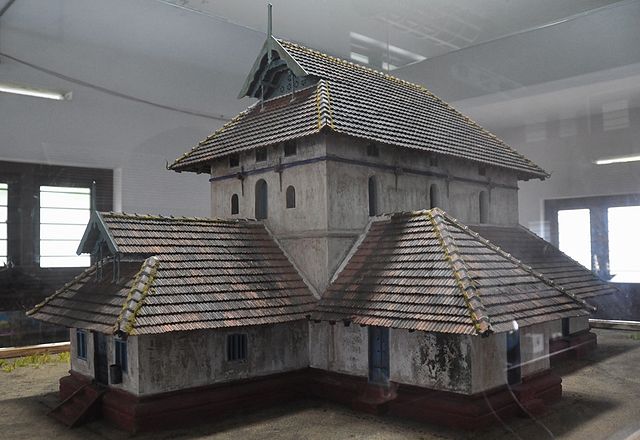Top Qs
Timeline
Chat
Perspective
Cheraman Juma Mosque
Claimed oldest mosque in Indian subcontinent From Wikipedia, the free encyclopedia
Remove ads
The Cheraman Juma Mosque is a mosque in Kodungallur, Thrissur district, in the state of Kerala, India. According to traditional legends, it is claimed that the mosque was built in 629 CE by Malik Bin Dinar[2] though some scholars suggest a later construction date in the 14th–15th century.[3] Due to these claims, it is often regarded as the first mosque built in India[2][4] and the oldest mosque on the Indian subcontinent still in use.[5][6][7] However, historical research has cast doubt on these claims, suggesting that the origin story may be fictitious or legendary rather than factual.[8]
An editor has expressed concern that this article may have a number of irrelevant and questionable citations. (June 2019) |
The mosque was built in the Kerala-Islamic traditional Vastu shastra architectural style, with hanging lamps, making the historicity of its date claims more convincing.[1][9][10][11][12][13][14][15][better source needed]
Modern corridors and halls were added in 1984, which surround the original building, and conceal almost all of the exterior features of the original structure.[3] A dome and minarets were added in 1994 and removed following a restoration of the building in 2022.[1]
The mosque is located on the Paravur–Kodungalloor Road.
Remove ads
History

One legend states that the mosque was built in 629 CE.[2][4] Other scholars are more skeptical and, based on the architectural style, have dated the structure from the 14th-15th century.[3]
Legend of Cheraman Perumals
According to some legends, the Chera king Cheraman Perumal witnessed a supernatural event mentioned in the Quran[16] The story goes that Cheraman Perumal arrived in Arabia with a gift of ginger pickles for Muhammad and his companions[17] and converted to Islam "at the feet of Prophet Muhammad".[18]
According to historian M.G.S. Narayanan, "there is no reason to reject the tradition that the last Chera king embraced Islam and went to Mecca, since it finds its place not only in Muslim chronicles, but also in Hindu brahmanical chronicles like the Keralolpatti, which need not be expected to concoct such a tale which in no way enhances the prestige of the Brahmins or Hindu population."[19][20]
Scholar Mehrdad Shokoohy however traced such legends to a much later accounts with different dating than the supposed earlier date.[3] Historical research has found this story to be fictitious.[8]
Remove ads
Visitors to the region

Several early Muslim or Arab travellers visited Kerala in medieval times. Among them were Sulaiman, in 851 CE;[21][full citation needed] Persian traveller Nakhuda Buzurg, in 951 CE;[22][full citation needed] Ibn E Batuta, in 1342 CE;[23] and Abd-Al-Razzaq, in 1442;[23][full citation needed] as well as many others. The Cheraman Juma Mosque was not mentioned in their respective writings.[21][full citation needed][22][page needed][23][24]
Since 2005, A. P. J. Abdul Kalam, the 11th President of India[citation needed] and Dr Shashi Tharoor, the Member of Parliament for Thiruvananthapuram,[25] have visited the mosque.
Remove ads
Appointment of the Aven (Priest)
According to Chellikkattil Sundaran, president of the Hindu temple trust, the aven (priest) of Shobhaparamba Sreekurumba Bhagavati temple in Tanur, Malappuram, is traditionally appointed from the local Thiyya family by a member of the Brahmin family of Pazhayakhath Ilom. The family disintegrated over the years and its remaining members converted to Islam, but both the temple authorities and the family upheld the tradition. The temple's Hindu priest is appointed in a special ritual once every 12 years, presided over by a Muslim member of the Pazhayakath family, who makes the formal announcement. Locals ascribe this camaraderie to Cheraman Perumal.[18][26]
See also
References
External links
Wikiwand - on
Seamless Wikipedia browsing. On steroids.
Remove ads


